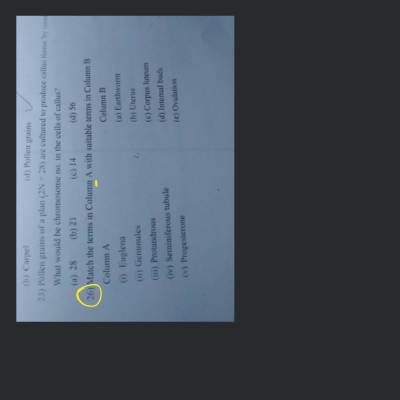Question
Easy
Solving time: 2 mins
Match the terms in Column A with suitable terms in Column B :

Found 4 tutors discussing this question
Discuss this question LIVE
12 mins ago
 Text solution
Text solution Verified
Verified
(i) (g);
(ii) (e);
(iii) (d);
(iv) (f);
(v) (b);
(vi) (a);
(ii) (e);
(iii) (d);
(iv) (f);
(v) (b);
(vi) (a);
Was this solution helpful?
106
Share
Report

One destination to cover all your homework and assignment needs
Learn Practice Revision Succeed

Instant 1:1 help, 24x7
60, 000+ Expert tutors

Textbook solutions
Big idea maths, McGraw-Hill Education etc

Essay review
Get expert feedback on your essay

Schedule classes
High dosage tutoring from Dedicated 3 experts
Practice questions from Modern ABC Biology Class 11 Part 1 (Modern ABC)
Question 3
Easy
Views: 5,425
Question 4
Easy
Views: 5,290
Practice more questions from Biomolecules
Question 1
Easy
Views: 5,918
Question 3
Hard
Views: 5,699
Practice questions on similar concepts asked by Filo students
Question 1
Views: 5,671
Question 2
Views: 5,119
Question 3
Views: 5,328
Question 4
Views: 5,190


Stuck on the question or explanation?
Connect with our Biology tutors online and get step by step solution of this question.
231 students are taking LIVE classes
| Question Text | Match the terms in Column A with suitable terms in Column B : |
| Updated On | Jun 2, 2023 |
| Topic | Biomolecules |
| Subject | Biology |
| Class | Class 11 |
| Answer Type | Text solution:1 Video solution: 1 |
| Upvotes | 156 |
| Avg. Video Duration | 2 min |





